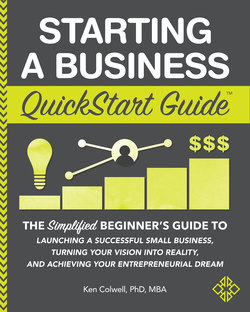Читать книгу Starting a Business QuickStart Guide - Ken Colwell PhD MBA - Страница 42
На сайте Литреса книга снята с продажи.
Flow
ОглавлениеIt turns out that mindfulness has an analog in psychology: the concept of flow.5 If you have ever felt like you were “in the zone,” congratulations—you have achieved a state of flow. Flow is the focused, productive, and uplifting feeling that comes with being totally immersed in a task. When you are in a state of flow, you lose track of time. Your concentration and focus are completely dedicated to the task at hand. What kinds of tasks produce a flow state? Those that present a challenge and that are intrinsically rewarding. Flow is mindfulness in real time.
Another way to think about flow is to define it based on what it’s not: anxiety, apathy, arousal, boredom, control, relaxation, and worry are states of mind that contrast with flow. When a task is much too difficult for our skill level it can cause feelings of worry and anxiety, as well as a feeling that we are not in control. Conversely, tasks that are no challenge at all or those that do not have outcomes that we view as valuable can cause boredom and apathy. Flow, then, is the sweet spot between a task that is too challenging and one that is too easy—and has an outcome that we are invested in.
Obviously, flow is the optimal state for learning and productivity. More than simply being a tool for getting the most out of your time, being in a state of flow feels good. It is a goal not only in the sense that it allows us to work at peak performance, but in the sense that it leaves us feeling tremendously fulfilled by the work that we do. Psychologists have conducted large amounts of research on how to achieve the flow state, but the short answer is mindfulness. When you exhibit the mindful approaches to vision, passion, and resiliency outlined above, you’re inviting the flow state.
There are eight characteristics of flow:
